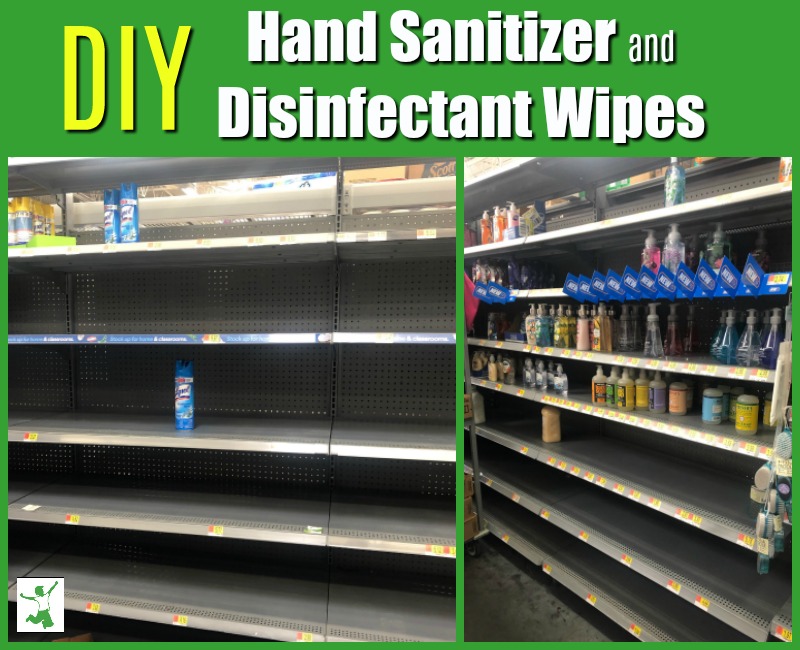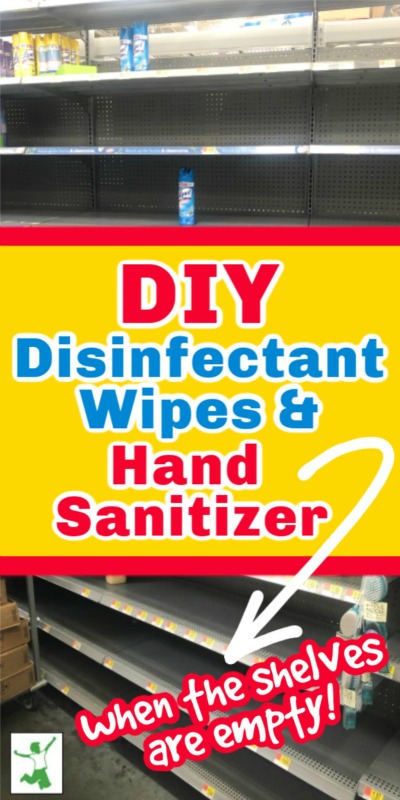Table of Contents[Hide][Show]
How to economically make homemade hand sanitizer and disinfectant wipes according to a Chemistry PhD to save money or in case stores run low on supplies during an epidemic.
The governor of my state announced the first two cases of coronavirus yesterday, and one of them happens to be in my community. The news alarmed a lot of people because, by dinnertime, supermarket shelves were nearly stripped bare of disinfectant, disinfecting wipes, hand sanitizer, and other related products!
I imagine that a similar scenario may be coming to a Wal-mart, Target or supermarket near you in the near future if it hasn’t already.
If the run on disinfecting products causes you to run short, no worries!
You can easily whip these products up yourself if you plan to be wiping down surfaces, doorknobs, and bathrooms more often than usual.
Going DIY will also cost you a lot less per use than the pre-made stuff at the store.
According to chemistry expert, Anne Marie Helmenstine, Ph.D., the active ingredient in homemade hand sanitizer should be 99.9% alcohol when mixed with aloe vera gel. (1)
Avoid substituting lower strength alcohol, hydrogen peroxide or witch hazel (which is fine for DIY baby wipes). The resulting mixture won’t produce a rapid enough anti-microbial effect if diluted with aloe vera gel. Lower strength alcohol should be used alone.
In other words, the total alcohol content needs to comprise at least 60% of the sanitizing mixture to be considered an effective disinfectant. (2, 3)
One more tip. If you choose to make your homemade disinfectant wipes with reusable materials such as bamboo paper towels, be sure to launder in hot water!
Anti-Microbial Essential Oils
If you choose to add the optional essential oils to the recipe below, I would suggest using ones that have anti-microbial properties of their own such as clove, thyme or tea tree. Use only 2 drops per batch with these stronger oils to avoid any risk of burning the skin.
If you choose essential oils such as vanilla or lavender purely for fragrance purposes, use 8-10 drops per batch.
Homemade Disinfecting Wipes and Hand Sanitizer
Make your own disinfecting wipes and hand sanitizer for pennies. Made with nontoxic ingredients with reusable paper towels option for safe, convenient sustainability.
Ingredients
- 1 roll paper towels HealthyHome15 for 15% off
- 2/3 cup 99.9% isopropyl alcohol
- 1/3 cup aloe vera gel preferably organic
- 2 drops anti-microbial essential oil optional (clove, tea tree, or thyme suggested)
Instructions
-
Mix the alcohol, aloe vera gel, and optional essential oil together in a glass jar to make a gentle but highly effective disinfectant. Pour into a cleaned, recycled hand sanitizer bottle. To make wipes, continue with additional steps below.
-
Cut each paper towel in the entire roll into four squares.
-
Make two stacks of the cut paper towels in a large glass bowl and pour the alcohol mixture evenly over them. Let stand until the liquid is fully absorbed.
-
If you find you need more liquid depending on the thickness of the paper towels you are using, mix up more alcohol/aloe vera mixture at a ratio of 2:1
-
Place the wipes in a large ziplock bag for convenient use at home or when traveling.
-
If using bamboo paper towels in order to re-use, store used wipes in a separate double seal ziplock bag for easy laundering as needed.
Recipe Notes
Make three batches of disinfectant wipes so that you have plenty of time to launder before you reach the end of the third bag.
In a pinch you can use ethanol or even 190 proof vodka to make your hand sanitizer or wipes.

References
(1, 2) Helmenstine, Anne Marie, Ph.D. “How to Make Homemade Hand Sanitizer.” ThoughtCo, Mar. 2, 2020, thoughtco.com/make-your-own-homemade-hand-sanitizer-606145.
(3) CDC: Guidelines for Disinfection and Sterilization in a Healthcare Facilities








Have you considered Benefect? No alcohol & no mixing. I love this stuff and don’t leave home without it. I even use it to sanitize my cutting boards after washing and rinsing them and for cleaning countertops.
S Rome – it looks like you have to go thru a distributor for Benefect? Not on Amazon?
Also, is it ok to use pure aloe vera gel from the plant, and if so, do I need to add citric acid or anything as a preservative? Thank you for this timely advice!
I haven’t used straight aloe vera from the plant, but I don’t see why that wouldn’t be fine. I wouldn’t suggest citric acid. The alcohol is plenty preserving enough! https://www.thehealthyhomeeconomist.com/citric-acid-ingredient/
Is it ok to store in a plastic sanitizer bottle, with tea tree oil, as I read essential oils should be in glass bottles. Would like to make bottles for my kid’s lunch boxes, in our cars, etc., so as much as I would prefer to use glass, not as good option with kids in daily usage. Appreciate any thoughts you have on this. Thank you!
I use plastic squeeze bottles myself for hand sanitizer containing essential oils. Glass is certainly optimal, but you have to weigh the practicality given specific situations. Essential oils are best in glass if they are in their pure form. Once mixed with other ingredients, in this case, alcohol and aloe vera which make up the vast majority of the mixture, I don’t think it is a big deal using plastic.
What is the recipe for a liquid hand sanitizer that can be placed in a bottle? Is it the same recipe? We can’t find bottled hand sanitizer anywhere. Thanks
To make the DIY hand sanitizer, use the ingredients in the recipe and follow step one only.
When I make this with the exact ingredients listed, it looks seperated and stringy no matter how much I shake it in the mixture in the mason jar. Is this normal?
What percentage alcohol are you using? If you use the 99.9% diluted 25% with aloe vera GEL (to keep it from being too harsh to the skin but the alcohol total percentage is still enough to be effective), it turns out the consistency of store hand sanitizer. Perhaps you are using aloe juice or 70% alcohol (which has water in it) which could perhaps account for the imperfect mixing effect?
I think you might have the replenishing ratio wrong and backwards. Alc: aloe 2:1, I think it should be.
Yes, you’re right. Thank you!
I’m overrun with homegrown aloe, might as well process some of it to further save on expense. I have 4 bottles of the “high-test” vodka in my preparedness stash too and every essential oil mentioned. Appreciate the simple recipe!
I read in a different recipe to add alcohol and essential oils to a mixer or jar and then blend or mix in the aloe slowly to emulsify, per mayonnaise instructions. Supposed to get proper texture this way. Don’t know but worth a try?
My daughter is extremely allergic to corn. Is there any other way to make hand sanitizer without corn based alcohol?
You can use 190 proof potato vodka. Perhaps there are some other corn-free ethanol options if you look around?
Hi Sarah,
I just clicked through to the Amazon link for the 99.9% Alcohol you reccomended, and it says it is NOT for use on human skin. Does adding the aloe make it safe? I’m confused.
Thanks for all you do!
Jill
Yes … it is very burning otherwise without the aloe vera, which is why pharmacy alcohol is only 70%. By the way, I link to the same brand linked to by the chemist listed in the references.
Hi Sarah,
I used 91% alcohol and decreased aloe as directed. I ended up with alcohol with a hard rubbery blob floating in it. No amount of mixing/shaking helped. I tried 2 different aloes, one by AMARA organics and one by natur-sense. I then tried 70% alcohol and put just a few drops of aloe in and it immediately turned into a rubbery stringy “thing”. I have wasted a 16 OZ. bottle of alcohol and I don’t know what I am doing wrong. Followed directions exactly. Any suggestions?
Susan
Are you using aloe vera gel or juice? My thought is that the lower strength alcohol didn’t mix as well with the aloe vera, which is why the chemistry expert (source of this recipe) recommended 99.9% strength alcohol for mixing with the aloe vera gel.
I used aloe vera gel as the recipe indicated. You think I should try juice? Has anyone out there used the juice who can comment?
As to the emulsifying effect. I did try using a wire whisk to mix the aloe in gradually. I put about a half teaspoon of aloe into the 91% alcohol and whipped it up. I didn’t see any rubbery strings and it looked like it was mixing in, until I removed the whisk which was loaded with rubbery strings. I hesitate to put this in my blender since I’m afraid the plastic will pick up the alcohol smell.
Juice does not work. The texture doesn’t turn out right. You also need to use 99.9% alcohol as the chemist indicated.
I’m flying next week, and have been reminding myself to get a good sanitizer recipe so I can wipe down tray tables, armrests, chairs at the airports, etc, without using toxic chemicals. Of course, I can find any number of recipes on Pinterest, but I really trust and recommend you, Sarah, so thanks for the timely advice!!!
Thank you for the kind words! The most important thing is to get alcohol that is strong enough to be virucidal … 99.9%. Most pharmacy alcohol is only 70%, so look for the most potent stuff to make your homemade sanitizer and wipes.
I just recently read that alcohol in sanitizers takes away the good microbiome from our hands…?
Yes, this is true. Washing hands with soap and water also strips the good microbiome from hands. But, during an epidemic, washing hands and using sanitizer is still a very good practice to keep from getting sick.